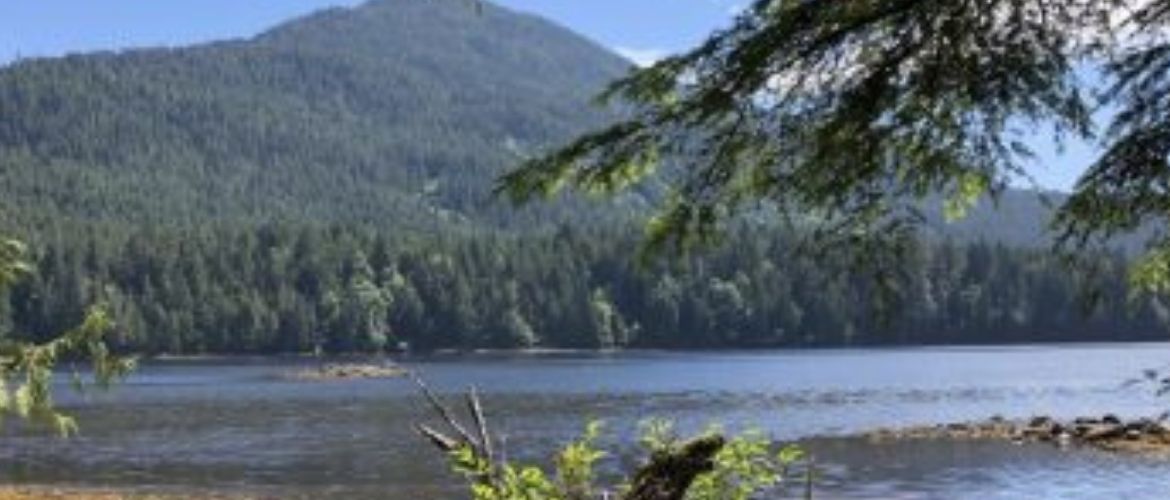
Transformative Educational Leadership Journal | ISSUE: Fall 2020
Principal Christine Franes walks us through the act of engaging with Indigenous wisdom, nature, and wonder as an act of self care. Taking time for self-care is important and necessary is we want to maintain the energy levels required of educational leadership. You are invited to walk alongside Franes in this photographic exploration of leadership.
By Christine Franes
I consider self-care important, but do I truly engage in self-care so that I am a successful and thriving educational leader, mother, wife, friend, or person?
How are my energy and stress levels throughout the day, week, month, and school year? Do I actually feel that self-care is selfish? Or do I value it enough to make choices and engage in self-care activities on a regular basis that benefit my mental and physical health? Building a self-care plan is important for leaders to reduce stress and to manage work demands (Hyland, 2018). What in my surroundings can I draw upon to thrive?
 Photo C Franes, Butze Rapids Trail, near Prince Rupert BC, July 2020
Photo C Franes, Butze Rapids Trail, near Prince Rupert BC, July 2020
I am fortunate to live, work, and learn in the traditional and unceded territory of the Ts’msyen and Sm’algyax speaking people. Prince Rupert and the Northwest coast of British Columbia have been my home for over 26 years, and some of the aspects about Prince Rupert that I loved from the moment I got here are the easy access to the outdoors and proximity and ability to be immersed in Indigenous, in particular Ts’ymsyen, Culture. School District 52 has approximately 64% Indigenous students and families, and working with students and families while learning about the culture of the Ts’msyen people has been an honour.
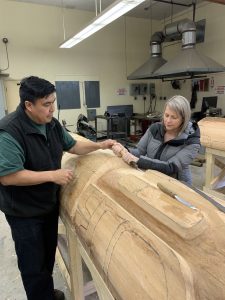 Photo L Burger, June 2020, Ts’msyen Artist Russell Mather carving Truth and Reconciliation
Photo L Burger, June 2020, Ts’msyen Artist Russell Mather carving Truth and Reconciliation
As a person with Indigenous Ancestry, I have always valued and appreciated Indigenous culture and wisdom. I have worked alongside many Indigenous colleagues and am grateful for the Indigenous knowledge they have shared with me. Debbie Leighton-Stephens, former District Principal Aborignal Education in School District 52, a colleague, mentor, and friend, took the time to explain many valuable aspects of Ts’ymsen culture. One of the teachings she helped me understand has resonated with me for a long time: the concept of Hagwil Ya’an. Debbie explained Hagwil Ya’an means to walk slowly, and I believe Hagwil Ya’an is an important component in a self-care plan.
The work of educational leadership is not without its challenges and levels of stress, and brief amounts of stress can enhance our ability to focus (Urban, 2020). The trick is to ensure that stress doesn’t persist for too long, as it can have undesirable and damaging effects:
If a leader experiences stress, neurotransmitters, and hormones are released and the leader may experience a short period of increased focus and reaction time. But if the stress exists for a long enough period of time, there will be negative consequences. Clearly there is a distinct need for leaders to practice self-care strategies to reduce stress and restore depleted energy stores in order to maintain peak performance. In our age of distraction and impatience, self-care can easily fall by the wayside during the mad daily rush (Urban, 2020, para. 3).
Taking the time for self-care is important and necessary to be able to maintain energy levels required of educational leadership.
Perhaps self care could even be a metric for success? Arianna Huffington (2015), successful business woman, author, and CEO of Thrive Global discusses money and power as the two traditional ways we measure success, but she suggests we need to use a third metric that consists of four pillars: well-being, wisdom, wonder, and giving. She claims people she observed who were thriving had provided space for well-being, wisdom, wonder, and giving in their lives. She argues that women in particular need to focus on the Third Metric because “women in stressful jobs have a nearly 40 percent increased risk of heart disease, and a 60 percent greater risk of diabetes. In the past thirty years, as women have made substantial strides in the workplace, self-reported levels of stress have gone up 18 percent” (2015, p. 24). Huffington further explains that stress levels have increased because we don’t allow the time to take care of ourselves, too focused on pursuing a fictional successful life and a work culture that is defined by stress, sleep deprivation and burnout. Stress, deprivation and burnout? Are these helping us to live our best lives? I think we need to shift our measure of success to examine if we are actively and regularly practicing self-care so that we are thriving in our lives. As leaders engage in self-care they are more able to take care of and support their colleagues, staff and family members. There are many strategies that one can apply to engage in well-being and self-care including exercise, meditation, mindfulness, practicing kindness, celebrating, and getting outside (Urban, 2020; Huffington, 2015).
 Photo C Franes, Butze Rapids Trail, near Prince Rupert BC, July 2020
Photo C Franes, Butze Rapids Trail, near Prince Rupert BC, July 2020
 Photo C Franes, Butze Rapids Trail, near Prince Rupert BC, July 2020
Photo C Franes, Butze Rapids Trail, near Prince Rupert BC, July 2020
Cognitive psychologist David Strayer explains that our brains are easily fatigued, and that the antidote for our distracting and multitasking modern life is nature (Williams, 2016). He further states that slowing down and taking in beautiful surroundings is restorative and improves our mental performance (Williams, 2016). Any time I engage in being in the outdoors, I think about what Debbie taught me, the Sm’algyax concept of Hagwil Ya’an, to walk softly or go gently. Williams (2016) explains many benefits of being close to nature, including referencing nature as a ‘social leveler’. Jill Sutie (2016) asserts that we are spending more time indoors and that this is not good for us, and that we need nature for our health for the following reasons:
- Being in nature decreases stress
- Nature makes you happier and less brooding
- Nature relieves attention fatigue and increases creativity
- Nature may help you to be kind and generous
- Nature makes you “feel more alive”.
(Suttie, 2016, para 6, 12, 17, 26, & 32)
Self-care for Leadership is critical to thrive while doing challenging and rewarding work. Accessing the outdoors and engaging in wonder through Indigenous wisdom and Hagwil Ya’an are of immense value, and I have engaged in these activities when I have the opportunity to do so on a local path called Butze Rapids Trail.
 Photo C Franes, Butze Rapids Trail, July 2020
Photo C Franes, Butze Rapids Trail, July 2020
As one enters the Butze Rapids trail, there is a sign indicating that wolves frequent the area. While practicing Hagwill Ya’an, I noticed that the trail also provides this information to visitors… Can you spot the wolf’s head?
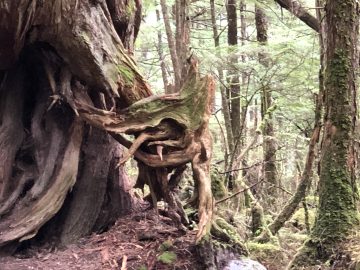 Photo C Franes, Butze Rapids Trail, near Prince Rupert BC, April 2020
Photo C Franes, Butze Rapids Trail, near Prince Rupert BC, April 2020
The trail is interpretive, and many signs are posted throughout that explain the local flora and fauna. Some of my favourite ‘blooms’ on the trail can be found in the spring.
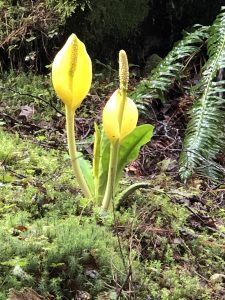
 Photos C Franes, Butze Rapids Trail, near Prince Rupert BC, April 2020
Photos C Franes, Butze Rapids Trail, near Prince Rupert BC, April 2020
I found today, as I practiced taking time for wonder, that Butze actually gives us a fist bump as we leave the trail!
 Photo C Franes, Butze Rapids Trail, near Prince Rupert BC, July 2020
Photo C Franes, Butze Rapids Trail, near Prince Rupert BC, July 2020
I feel grateful to live in such an amazing place that provides easy access to the outdoors and nature, and affords many opportunities to engage in self-care while utilizing wonder and wisdom. While on summer break I connected with nature daily, and my challenge for this Fall is that I continue to explore a regular connection as a strategy for frequent self-care so that I might thrive in all areas of my life.
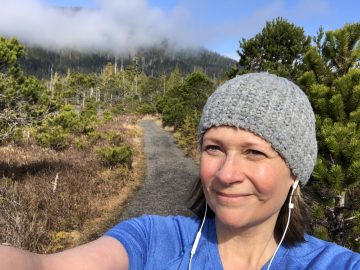 Photo C Franes, Butze Rapids Trail near Prince Rupert BC, April 2020
Photo C Franes, Butze Rapids Trail near Prince Rupert BC, April 2020
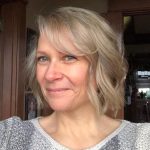
Christine Franes
LinkedIn | Twitter
Christine is the District Principal Learning Services in School District 52, Prince Rupert. Christine feels fortunate to live, work, and raise a family in traditional Ts’ymsyen territory, and is grateful for the many learning and career opportunities she’s had over the 26 years she has lived in Prince Rupert. Wife and mother of three teenagers, she enjoys learning new things, running, being outdoors and spending time with her family and friends.
Huffington, Ariana, 2015. Thrive: The Third Metric to Redefining Success and Creating a Life of Well-Being, Wisdom, and Wonder. Harmony Books, Penguin Random House Company.
Hyland, Patrick, 2018. Leadership and the importance of self-care. https://www.mercer.ca/en/our-thinking/career/leadership-stress-and-the-importance-of-self-care.html
Suttie, Jill, (2016). How nature can make you kinder, happier, and more creative. https://greatergood.berkeley.edu/article/item/how_nature_makes_you_kinder_happier_more_creative
Urban, Erin, 2020. Seven self-care strategies for successful leaders. https://www.forbes.com/sites/forbescoachescouncil/2020/02/21/seven-self-care-strategies-of-successful-leaders/#67e1961054f1
Williams, Florence, 2016. This is your brain on nature. https://www.nationalgeographic.com/magazine/2016/01/call-to-wild/
 Photo C Franes, Butze Rapids Trail, near Prince Rupert BC, July 2020
Photo C Franes, Butze Rapids Trail, near Prince Rupert BC, July 2020 Photo L Burger, June 2020, Ts’msyen Artist Russell Mather carving Truth and Reconciliation
Photo L Burger, June 2020, Ts’msyen Artist Russell Mather carving Truth and Reconciliation Photo C Franes, Butze Rapids Trail, near Prince Rupert BC, July 2020
Photo C Franes, Butze Rapids Trail, near Prince Rupert BC, July 2020 Photo C Franes, Butze Rapids Trail, near Prince Rupert BC, July 2020
Photo C Franes, Butze Rapids Trail, near Prince Rupert BC, July 2020 Photo C Franes, Butze Rapids Trail, July 2020
Photo C Franes, Butze Rapids Trail, July 2020 Photo C Franes, Butze Rapids Trail, near Prince Rupert BC, April 2020
Photo C Franes, Butze Rapids Trail, near Prince Rupert BC, April 2020
 Photos C Franes, Butze Rapids Trail, near Prince Rupert BC, April 2020
Photos C Franes, Butze Rapids Trail, near Prince Rupert BC, April 2020 Photo C Franes, Butze Rapids Trail, near Prince Rupert BC, July 2020
Photo C Franes, Butze Rapids Trail, near Prince Rupert BC, July 2020 Photo C Franes, Butze Rapids Trail near Prince Rupert BC, April 2020
Photo C Franes, Butze Rapids Trail near Prince Rupert BC, April 2020


Hi Christine. This is awesome! I read and listened! I am thankful to have worked with you in the past…and present…always such great advice and knowledge.
This is beautiful Christine, thank you for sharing Hagwil Ya’an. It is helpful in this time. To walk slowly. Your photos shed new light.
Well done, Christine! An important topic to be explored.
HI Christine, I am very happy for all your accomplishments in Prince Rupert, you have been a good asset to our School District! Congratulations!!!
Thank you for this important reminder.